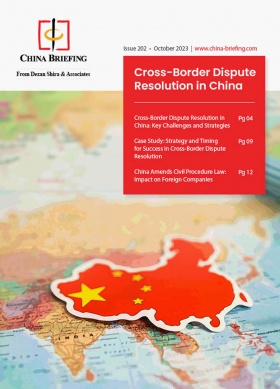China’s Cross-Border E-Commerce: 2023 Performance and 2024 Outlook
In 2023, China experienced a significant 15.6 percent surge in cross-border e-commerce (CBEC) import-export volumes, solidifying its position as a global leader in this sector. This growth was largely attributed to government initiatives aimed at fostering a favorable environment for CBEC, including the optimization of comprehensive pilot zones, and the advancement of the ‘Silk Road e-commerce’ under the Belt and Road Initiative.
Amid ongoing macroeconomic challenges, the cross-border e-commerce (CBEC) sector has emerged as a pillar of expansion, with China showcasing remarkable performance and solidifying its position as a global leader in this domain.
According to data released by the State Council, China’s CBEC experienced a significant surge in import-export volume, reaching a total of RMB 2.38 trillion (US$331 billion). This growth, which amounted to a remarkable 15.6 percent, was driven by a 19.6 percent rise in exports and a steady 3.9 percent increase in imports.
This noteworthy expansion of China’s CBEC sector not only underscores its resilience but also highlights its pivotal role as a driving force in the country’s foreign trade. CBEC has emerged as a new format with great potential, offering a new bright spot in China’s foreign trade endeavors.
This article will delve into this growing trend, presenting the key data points and providing insightful analysis to shed light on the dynamics driving China’s 2023 performance in the CBEC sector.
China’s leading position in the CBEC area
The global trade scenario is currently facing numerous challenges, including supply chain crisis, geopolitical disputes, and regional protectionism. For this reason, companies are increasingly seeking to mitigate risks by diversifying their markets. In response to this imperative, CBEC has emerged as a practical and secure solution that businesses have increasingly turned to in recent years as, by leveraging online platforms, companies can expand their brand presence globally and reach a diverse array of customers without heavy upfront setups.
In this landscape, China stood out as a dominant force in CBEC. In 2022, it solidified its leading position in the CBEC area, as evidenced by Statista’s findings, ranking as the primary market for cross-border purchases in major economies such as the United States, and the United Kingdom.
In the same year, China’s CBEC import and export value exceeded RMB 2 trillion for the first time, increasing by 7.1 percent compared to 2021. This growth was attributed to two main causes:
- The increased number of companies selling products online; and
- The increased number of consumers relying on online shopping for better deals during the global economic slowdown and the COVID-19 pandemic.
In 2023, this trajectory remained consistent, further underscoring China’s prowess in the CBEC arena.
China’s CBEC performance in 2023
In 2023, China’s CBEC import and export volume surged to RMB 2.38 trillion (US$331 billion), marking a significant 15.6 percent increase year-on-year. This growth rate exceeded the previous year’s one, indicating the ongoing momentum in China’s CBEC landscape.

As visible in the chart, CBEC import and export volumes have been following a consistent upward trajectory over the years, thanks to the ongoing development of globalization and new technologies, such as AI. Despite fluctuation registered in the growth rate for both imports and exports, the overall performance in recent years has been steady and upward with exports consistently outpacing imports.
Notably the export segment experienced a particularly strong growth in 2023 with a year-on-year surge of 19.6 percent, surpassing the 2022 growth rate of 10.1 percent, and reaching a total value of RMB 1.83 trillion (US$254.4 billion). This underscores the enduring demand for Chinese products in international markets.
On the other hand, the import segment saw a more modest increase of 3.9 percent year-on-year, with a value of RMB 548.3 billion (US$76.2 billion), representing an improvement compared to the 0.8 percent decrease registered in 2022. In this regard, the expansion of this segment is mirrored by the growing engagement of consumers, which reached 163 million in 2023. This annual increase is largely attributed to CBEC’s ability to easily meet consumers’ diverse and personal needs. Although the growth rate in imports trails that of exports, it nonetheless signifies a notable recovery in the influx of foreign goods into the Chinese market through CBEC channels.
This data suggests a new deep and long-standing period of development for the CBEC sector, propelled by a growing number of companies that get attracted by this sector. As a matter of fact, as of July 2023, more than 100,000 market entities got engaged in CBEC activities, underscoring the sector’s pivotal role in China’s foreign trade. With the increased number of players entering the market, however, competition among them has become more intense, as suggested also by the South China Morning Post. This trend has prompted companies to increasingly focus on foreign markets to seize larger growth opportunities.
Initiatives like Alibaba’s ‘digital trade service base’ in Shanghai, aimed at bolstering local merchants venturing into overseas markets, exemplify this strategic shift. Following this initiative, Alibaba’s international operations recorded a remarkable 53 percent revenue growth, reflecting the robust expansion of the overseas market. This trend is not exclusive to Alibaba but encompasses many other e-commerce giants, who are opening up new opportunities for the development of CBEC while also becoming a new channel for many small and medium-sized enterprises (SMEs) to expedite their international expansion.
Policies contributing to China’s cross-border e-commerce sector growth
The rapid growth of China’s CBEC sector in 2023 can be largely attributed to supportive government policies aimed at facilitating both import and export activities.
To foster and expand the CBEC sector, multiple departments including Ministry of Commerce (MOFCOM), National Development and Reform Commission (NDRC), Ministry of Finance (MOF), General Administration of Customs (GACC), and State Taxation Administration (STA) have been playing a crucial role in making concerted supporting policies.
Preferential tax treatments and minimal administrative requirements
China has been offering preferential tax treatment and easing administrative requirements to support the development of CBEC.
For products sold to Chinese consumers through cross-border trade, transactions valued below RMB 5,000 or total annual e-commerce transactions below RMB 26,000 are exempt from import tariffs and can enjoy a 30 percent value-added tax or consumption tax reduction if applicable.
Moreover, selling directly to Chinese consumers via cross-border trade comes with the advantage of minimal administrative requirements. In addition to not requiring a legal entity in China, the customs clearance and the labeling requirements might be less stringent compared to general trade, subject to certain qualifications. Many platforms also support merchants by handling administrative affairs like customs registration and clearance procedures.
Timely policy adjustments
Among others, to meet the growing demand of Chinese consumers, particularly for products in categories like beauty, fragrance, and nutrition, China adjusted and optimized the list of imported retail goods for cross-border e-commerce in 2022 by adding a total of 29 new product categories. This regulatory adjustment was designed to streamline the import processes, ensuring that consumers have access to a wider range of high-quality products from overseas.
Besides, the CBEC sector remains an attractive avenue for new foreign brands seeking to enter the Chinese market, as it offers relatively low entry barriers and a cost-effective approach. Dedicated platforms such as Tmall and JD.com are contributing to the fostering of a conducive CBEC environment for international brands by actively implementing policies aimed at easing their market entrance. These initiatives include enabling official flagship stores, empowering brands to establish a direct presence and sell directly to Chinese consumers, and helping with setting up global payment accounts for seamless international transactions.
On the export side, the GACC implemented measures to support CBEC enterprises and reduce operational barriers. The introduction of an online tax payment function and the facilitation of customs clearance procedures helped to lower costs for exporters, making it easier for them to engage in international trade.
Additionally, the increased demand for “fast fashion” retail goods from overseas clients, pushed the development of a piloted program for the return of CBEC retail import and export goods across customs zones, which addressed concerns related to returns, enhancing confidence among enterprises and consumers alike.
“Silk Road e-commerce” and Belt and Road economic and trade cooperation
To ensure the steady and sustainable growth of CBEC exports, the relevant departments also encouraged companies to actively participate in the “Silk Road e-commerce”, an international platform for economic cooperation under the Belt and Road Initiative (BRI). This project actively promotes the expansion of bilateral cooperation between China and countries along the BRI route. By fostering collaboration with 30 countries by October 2023, China not only expanded market access but also catalyzed growth in industries like logistics and finance.
This strategic initiative gains further significance amidst escalating tensions with Western counterparts, positioning the BRI as an alternative avenue to fully harness the potential of CBEC.
Shanghai, in particular, plays a pioneering role in expanding opening-up in the e-commerce field, through the establishment of a Silk Road e-commerce pilot zone, poised to attract internationally competitive e-commerce firms and foster unique regional logistic networks, and shared public service platforms. This initiative is expected to create opportunities for collaboration in an open and fair environment.
Comprehensive pilot zones
At the same time, the continued development of integrated pilot zones for CBEC has also provided an objective contribution to the growth of this sector. The comprehensive development of these pilot zones has proven to be instrumental in driving industry expansion, amplifying CBEC transaction volume, and streamlining enterprise registration procedures. By optimizing key components such as payment systems, customs clearance procedures, logistics infrastructure, and warehousing facilities, these zones have effectively simplified transaction processes and minimized associated costs.
By 2023, the State Council had already approved the establishment of 165 pilot zones covering 31 provinces, autonomous regions, and municipalities. These serve as pivotal hubs for transforming and upgrading traditional sectors while promoting digitalization. However, to fully achieve this transaction it still requires a lot of effort as significant issues such as scarcity of professional talents, absence of core products, stability concerns, market limitations, and standardization conflicts, are yet to be tackled.
The government has also been encouraging a further upgrade of this zone into a model that integrates CBEC pilot zones and industrial belts to facilitate business-to-business exports. Shandong represents a successful example of this new model as in the first 11 months of 2023, its new import and export of new foreign trade formats, including cross-border e-commerce, was RMB 260.48 billion (US$36.22 billion), demonstrating the functionality of this new project.
2024 outlook
In the outlook for 2024, several factors, such as the ongoing global unrest like the Red Sea Crisis, may potentially hinder the growth rate of CBEC by impacting global shipping and e-commerce landscapes, thus affecting consumer confidence.
Despite this, the Chinese government expressed commitment to advance the improvement and innovation of comprehensive pilot zones for CBEC underscoring its dedication to fostering an environment conducive to the growth of this sector. Furthermore, additional efforts will be placed in tackling regulatory and standardization issues, while also promoting a further optimization of transportation and delivery systems.
Finally, China’s well-known focus on innovation is poised to exert a significant influence also on the continuous development of CBEC, further solidifying its position as a cornerstone of China’s foreign trade strategy.
Due to the convergence of these factors, it can be expected for CBEC to continue growing and innovating in the next years, further strengthening China’s position as a global leader in CBEC and underscoring its increasing reliance on this form of foreign trade.
About Us
China Briefing is written and produced by Dezan Shira & Associates. The practice assists foreign investors into China and has done so since 1992 through offices in Beijing, Tianjin, Dalian, Qingdao, Shanghai, Hangzhou, Ningbo, Suzhou, Guangzhou, Dongguan, Zhongshan, Shenzhen, and Hong Kong. Please contact the firm for assistance in China at china@dezshira.com.
Dezan Shira & Associates also has offices in Vietnam, Indonesia, Singapore, United States, Germany, Italy, India, and Dubai (UAE). We also have partner firms assisting foreign investors in Australia, The Philippines, Malaysia, Thailand, Bangladesh.
- Previous Article How to Legally Handle Sensitive Personal Information in China
- Next Article Record Highs in Travel, Consumption Boost Mark 2024 Chinese Spring Festival Holidays








